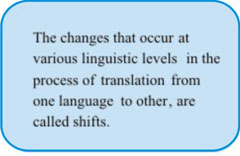Shifts
In the attempt to attain equivalence, there occurs what Catford defines as ‘shifts' o “departures from formal correspondence in the process of going from the SL (source language) to the TL (target language)” (Venuti 141). In other words, the changes that the translation undergoes in its attempt to attain equivalence with the SL text can be called shifts. Catford identifies two types of shifts – level shifts and category shifts. “departures from formal correspondence in the process of going from the SL (source language) to the TL (target language)” (Venuti 141). In other words, the changes that the translation undergoes in its attempt to attain equivalence with the SL text can be called shifts. Catford identifies two types of shifts – level shifts and category shifts.
Level shifts occur when one word at a particular linguistic level has an equivalent at a different level. A noun in the SL might not be replaceable with a noun in the TL because that particular word is awkward or wrong in the TL context. For example, the simple English sentence, “It is morning” (indicating the time of day) cannot be replaced exactly in Hindi or most Indian languages. We need to rephrase it to clarify the meaning.
Category shifts are the changes brought about in the various parts of a text, viz. sentences, clauses, groups of words etc. Here Catford makes a distinction between unbounded and rank-bound translation. What is intended by ‘rank' are the different levels of the text, from sentence to morphemes. Unbounded translation is free and the equivalence between SL and TL is set up at whatever rank that is suitable for the translation. Rank-bound translation takes place when equivalence is sought to be attained at levels lower than the sentence; shifts that occur at this level result in bad translations as the TL text will not be an easy read. Structure shifts take place because there are no structural correspondences between two languages. Shifts also occur at various other levels.
Shoshana Blum-Kulka talks about shifts of cohesion and coherence that can occur in translation. Borrowing terms from discourse analysis, she defines coherence as “a covert potential meaning relationship among parts of a text, made overt by the reader or listener through processes of interpretation” and cohesion as “an overt relationship holding parts of the text, expressed by language specific markers” (Venuti 299). Her argument is that translation is sometimes “explicitation” or it augments the cohesiveness by repetition or explanation. The translation sometimes alters the semantic pattern of the SL text, perhaps due to reader response or the contextual factors surrounding the TL text resulting in shift of coherence. |